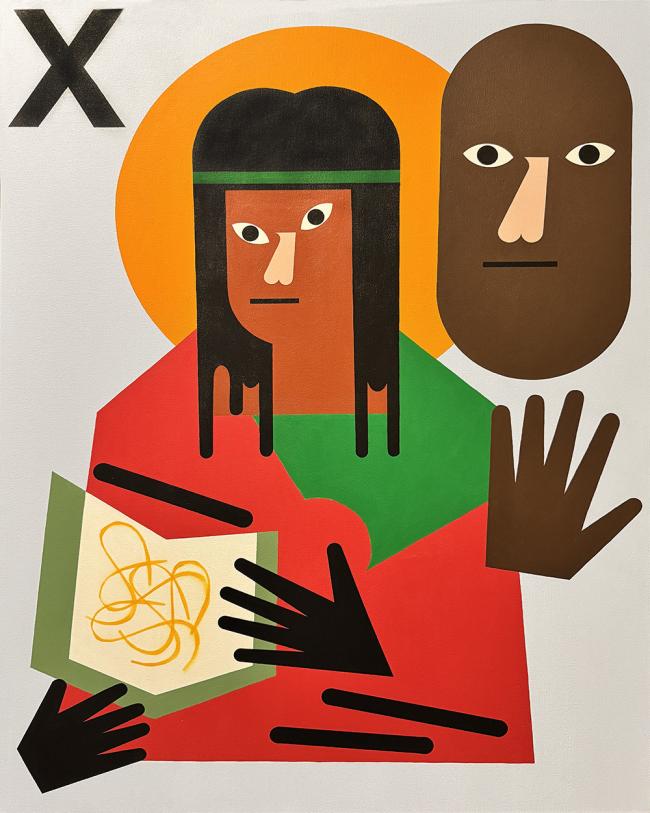Nina Chanel Abney ’04: 'Manifest'

"Manifest"
Nina Chanel Abney, 2025
Acrylic and spray paint on canvas
36" x 48"
Artist statement
This painting explores broad ideas of spirituality, belief systems and the ways people seek meaning in their lives. The work reflects on organized religion as one of many frameworks for finding guidance, while also engaging with the kinds of modern mantras and affirmations we see in popular culture, such as Home Goods-style wall hangings commanding, “Live, Laugh, Love.” The image plays with these motifs by critiquing their commodification, while also acknowledging the comfort they bring to some.
For generations, Black families and households have traditionally displayed portraits of a white Jesus on their walls, a relic of colonialism and the pervasiveness of Eurocentric Christian iconography. This presence — often found in living rooms, dining spaces or even over beds — has long shaped notions of faith, salvation and identity within Black communities.
Abney subverts this legacy by reimagining the divine in her own visual language, often incorporating Black figures in spaces of reverence, power and spiritual significance. At its core, this work reimagines these symbols in a way that’s inclusive, letting each viewer find their own meaning — whether it’s spiritual, motivational or simply aesthetic. The work conceptually mirrors the role of spirituality in people’s lives, which often serves as a deeply personal framework, providing guidance, comfort or meaning uniquely tailored to each individual.
Nina Chanel Abney (1982-present)
- Born in Harvey, Ill.
- B.F.A., Augustana College, Rock Island, Ill., 2004
- M.F.A., Parsons School of Design, NYC, N.Y., 2007
- Artist's website: ninachanel.com
Combining representation and abstraction, Nina Chanel Abney’s paintings capture the frenetic pace of contemporary culture. Broaching subjects as diverse as race, celebrity, religion, politics, sex and art history, her works eschew linear storytelling in lieu of disjointed narratives. The effect is information overload, balanced with a kind of spontaneous order, where time and space are compressed and identity is interchangeable. Her distinctively bold style harnesses the flux and simultaneity that has come to define life in the 21st century. Paying homage to the sophisticated color theories of Matisse; continuing the legacy of cubists, Picasso and Léger; and connecting with the synesthetic sensibilities of Harlem Renaissance greats, Douglas and Lawrence, Abney brings these historical movements into contemporary pertinence.
Abney’s groundbreaking influence has been the center of scholarly praise by art historian Richard J Powell. He notes, “Abney’s dramatic patterns, geometric configurations, serrated fragments, and compositional convergences and disassemblings reimagine an art object’s geodesic position both to the viewer and within the canon. She proposes a reimagined Cubism where color, form and rhythm function counterintuitively as a presence, an accentuation and evidence of the painting’s internal pulse. Abney’s works jolt viewers’ internal sense of equilibrium towards agitation, excitement and ultimately an inner jouissance — a suspended disbelief in equanimity.”
Through a bracing use of color and unapologetic scale, Abney’s canvases propose a new type of history painting, one grounded in the barrage of everyday events and funneled through the velocity of the internet.
